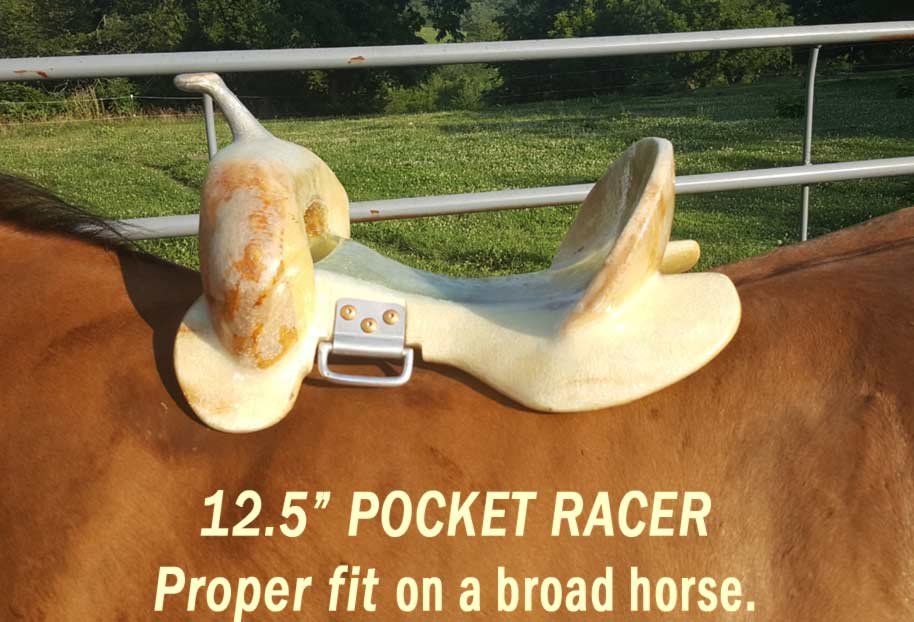
LEN BROWN'S BLACK MESA SADDLE TREES with a LIFETIME GUARANTEE
THIS PAGE IS TO EDUCATE ON LEN'S BLACK MESA SADDLE TREES. It is also to show regular trees & the problems that are often encountered. SELECTION OF OUR HORNS FOR ORDERING YOUR SADDLE ARE AT THE BOTTOM OF THIS PAGE. We have the widest variety you'll find anywhere because we have our horns cast from our own matchplates & don't just purchase from other suppliers. Roper horns are either heavy aluminum or solid brass. Stirrup Loops are another exclusive that we have cast for use in Brown's Custom Black Mesa Saddles. They leave the tree bars thick at the normal weak spots in other saddle trees. The loops give freer swing of the stirrup straps. Third: they make for a narrow waist by not having to build thick bars for the strap grooves top & bottom. Most other trees only have a groove in the top of the bars to keep from having breakage at the weak spot in normal trees. That is why all of today's saddles have the set of knuckles from the straps under the tree bars. Once the skirts are broken in those strap bumps cause performance & behavior problems.
WHEN A HORSE REACHES WITH THE HINDQUARTERS THE BACK COMES UP 2" OR MORE RIGHT AT THAT STRAP BUMP & THEY SOON STOP REACHING.
BLACK MESA ID TREES (Intelligent Design Trees) by Len Brown
DESIGNED TO WORK FOR YOUR HORSE AND MAKE YOU A BETTER & MORE COMFORTABLE RIDER! The HAPPY BACKS & BOTTOMS SADDLE CLUB that was formed in Houston years ago, says it all, they rode my saddles exclusively.
TODAY'S SADDLE INDUSTRY IS BASED ON trees with angles TOO FLAT. The R&D Manager of CACTUS SADDLERY told me, we don't want the bars interfering with the horse's shoulders, that's why they are turned out at the bottom in front. I told him that was the problem with saddles today, they are all turned out at the foot in front & called Quarter Horse or Full Q/Horse. Even the Semi Q/Horse bars are too flat in angle & too curved front to rear. Gaited horse trees add extra bar flare to the above problems and are some of the worst for function on a horse. (fifty yrs ago Arizona Bars were made this way too) Didn't work too well then and some saddlemakers are still using them.
these flat angles put extra curve in the saddle front to rear. This causes: pinching at the top half of the bars in front, it sores the mid-back, and as the horse reaches with the hindquarters the back rounds & tree works up and down in the front. Then it pinches and rubs every stride. That is where your horse's patches of white hair come from. My Black Mesa trees are not made that way and neither were my ORTHO-FLEX SADDLE TREES MADE THAT WAY. I changed the way my ORTHO trees were made in 1986 to help remedy this problem. I opened the gullet at the top and brought the bars together at the bottom in the front. That is called adding TWIST to the bars. As they open to stop pinch at the top, they come together to support the saddle at the bottom on the upper rib cage in front. (the only way to stop pinching of the withers) This TWIST ALSO STRAIGHTENS A TREE FRONT TO REAR. I then dish out the bars in the WAIST of the seat for a narrow close contact feel for the rider. Extra TWIST also flattens the angles in the rear of the BARS. Then the horse can bend and turn without the sharp outside edge of a bar BITING HIM IN THE OUTER LOIN. Now take a look at some of the exclusive trees my saddles are made on. Regards, Len
What the treemakers and saddlemakers don't realize is:
Len’s 240 lbs on the GET DOWN roper tree. There’s a video on F/B “Rope to Win”, shows “NO PINCH TWIST BARS” in action. This DUN has wide low withers, the 8 & 3/8ths Inch gullet is from the twist.
The ignorance of today's tree & saddlemakers is best illustrated with this picture of his kid's old saddle. This customer has 2 custom made Wade saddles. They both pinch this horse severely at the top of the bars. This is one of his Quarter horses that gets worked a lot. With almost 10 grand down the tubes on his saddles, he can't work without the Protector Pad. The Wade still pinches but it lets him ride full time & do his job with less horse/saddle problems than his buddies on the job.
No Loss Purchasing Plan for Saddle & Pad Orders
Within 30 days after receiving your saddle if it doesn’t meet your expectations, you can trade it back for another saddle. What you have spent on your saddle will be applied to the new model of equal or greater value. You are responsible for the return shipping to orthoflex saddle company. Len will pay for shipping the new saddle back to you. Repairs or replacements are at the full discretion of Len Brown. Call to get an authorized return number from Len. Unauthorized saddle shipments will not be accepted.
For Protector Pads there is a 30-day trial period. There is a 20% restocking fee for returns. Size adjustment for cinches. Call for an authorization # we do size replacements.
Cinch Size Replacement
Within 2 Weeks of receiving your cinch you can exchange it for a different size. Call for a return authorization # ship your cinch to us & we will send your new cinch back to you.















